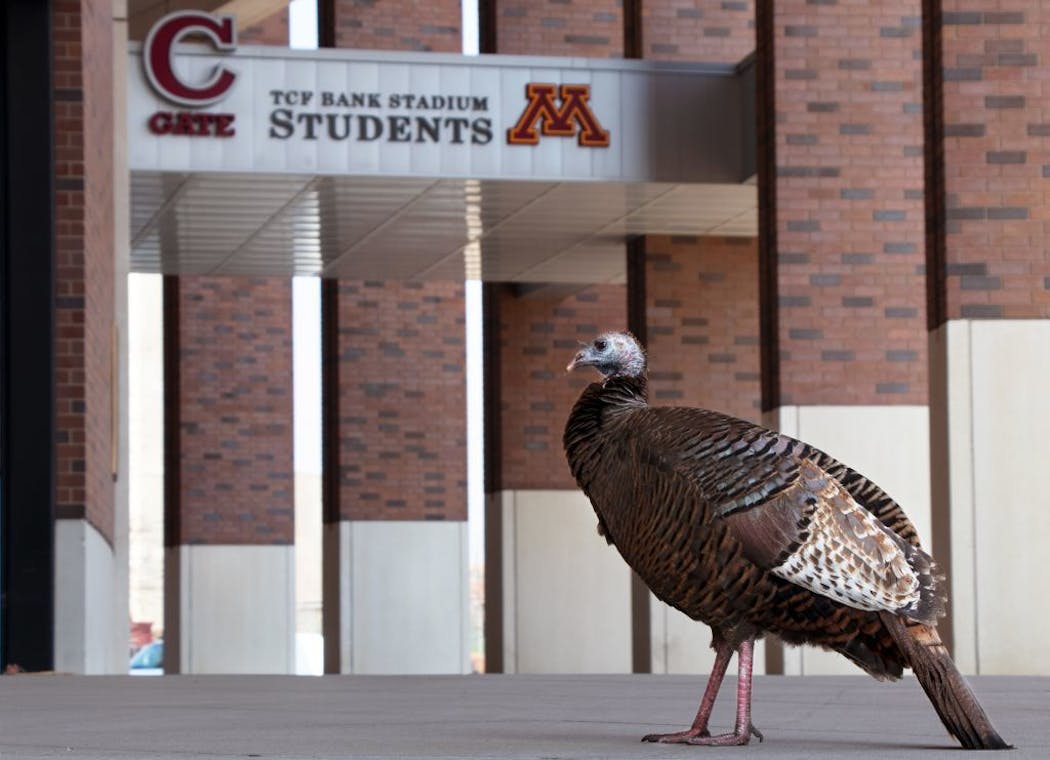Why do wild turkeys seem to thrive in the Twin Cities metro?
Listen and subscribe to our podcast: Via Apple Podcasts | Spotify | Stitcher
It's one thing to yield to a red light or a pedestrian — it's another to yield to a group of 25-pound birds whose feathers aren't too ruffled by the honking.
What might have been a bizarre experience a couple decades ago is now a fairly commonplace occurrence for Bryn Mawr resident Peter Redmond, who consistently sees flocks of six or more wild turkeys on his drive to and from nearby cities.
"My most recent anecdote happened near the intersection of Hopkins Crossroad and Cedar Lake Road, near the Aldi entrance," Redmond said. "A dozen adult birds [were sauntering] across the street as traffic yielded."
There are now more than 70,000 wild turkeys across Minnesota due to the Department of Natural Resources' conservation efforts. Deforestation and unregulated hunting nearly brought the turkey population to zero in the 19th century before the DNR's wildly successful campaign. Naturally, more turkeys means more turkey encounters like the ones Redmond has on his commutes.
Redmond turned to Curious Minnesota, our community-driven reporting project fueled by reader questions, to ask: "How do wild turkeys thrive in the metro area? Do they build nests? Where are their babies born?"
Redmond isn't alone in his curiosity; according to Melissa Mayntz, professional birder and author, turkeys are one of the most popular topics when it comes to bird sightings.
"Wild turkeys are fascinating because they are extremely adaptable," Mayntz said. "Most importantly, they're omnivorous, so ... as there's food available, they'll find it and they'll stay."
Bird feeder spillage, unsecured trash and fruit or nut-bearing trees are all common food sources in urban areas that could make a flock — also known as a gang, a gobble, or a posse — comfortable with putting down roots. According to Mayntz, large flocks (or gobbles) can be very common, particularly if there's abundant food and space for them to roam.
While they nest in the ground wherever there is sufficient shrubbery coverage, wild turkeys roost in large, mature trees overnight.
"In metro areas, there are more spaces for turkeys than you might imagine," said Mayntz, who runs the website, beyourownbirder.com. "Cemeteries are a big spot where you might see a flock of turkeys. The buffer zone around an airport, even a small airport, can have big trees where turkeys will be perfectly happy to hang out. Larger parks or even golf courses can also be very easy habitats for wild turkeys."
However, while there's plenty to make a flock of turkeys stay, there's not much to drive them out. In urban areas, wild turkeys, as large as they are, have few natural predators.
"They're also a little more on the aggressive side, so they'll be chasing other birds and wildlife away," Mayntz said. "Dogs, cats, skunks or raccoons can prey on eggs, but the adult turkeys — there's nothing really to stand in their way."
Mail carriers, commuters and even law enforcement officers have found that out the hard way.
Even when they manage to stay out of the road, wild turkeys can dig up landscaping, scratch vehicles and attack pets or humans.
"In a lot of places, especially ones with homeowners associations, a flock of wild turkeys coming to a backyard feeder or just visiting a garden isn't exactly going to be welcome," Mayntz said. "In many cases, it's just a good idea to leave them be. Don't encourage them."
According to Mayntz, flocks will typically move on if their food sources are removed. If a bird becomes troublesome, said Mayntz, call your local wildlife official. Mostly though, the best thing to do is to just leave it to its own devices.
"It's not worth agitating that bird to get a selfie," Mayntz said.
Reporter Anna Ta can be reached at anna.ta@startribune.com
---
If you'd like to submit a Curious Minnesota question, fill out the form below:
Read more Curious Minnesota stories:
Is it true that Minneapolis has a park every six blocks?
If there's a 'Greater Minnesota,' where is 'Lesser Minnesota'?
Why do tiny cities like Lauderdale, Landfall and Falcon Heights exist?
Why is Minnesota more liberal than its neighboring states?
When you flush a toilet in the Twin Cities, where does everything go?
Was Minnesota home to nuclear missiles during the Cold War?
How did Minnesota become known as the 'Land of 10,000 Lakes?
When did wild bison disappear from Minnesota?



